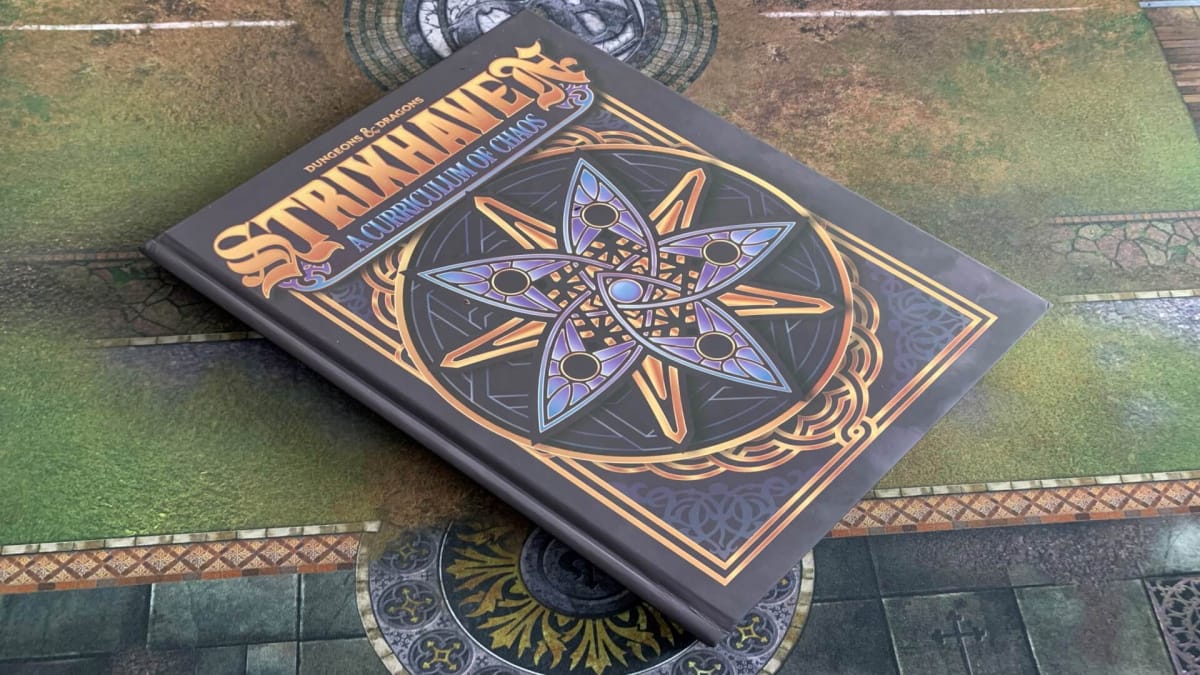The idea of the magic school has become one of the most ubiquitous tropes in YA fiction in recent years. Thanks in part to certain popular books and television shows, it's a format that resonates with a large audience. And given just how vast and imaginative the world of Dungeons and Dragons is, it was a matter of time before something like Strixhaven: A Curriculum of Chaos would be introduced. Inspired by the Magic: The Gathering set released in April, Strixhaven is equal parts sourcebook and prewritten adventure. There is a lot to enjoy here, even if some of the elements feel more fleshed out than others.
Strixhaven: A Curriculum of Chaos – New Player Options
Picking up Strixhaven: A Curriculum of Chaos gives players access to several new feats as well as a new playable race. The biggest draw is a new Background, Strixhaven Initiate, which allows players from any class access to several cantrips and a level one spell. As for the new race, the Owlin, they manage to stand out from another avian race, the Aarokocra, thanks to having both their walking and flying speed be equal as well as having a bit more flexibility in terms of ability score distribution.
I mentioned the benefits and design intentions behind these elements before in our preview of the book, and most of these thoughts still stand. The idea that Strixhaven Academy contributes to a more democratized (assuming you can pay the tuition) approach to teaching magic does help add a new dimension to otherwise straightforward classes. Sorcerers can learn spells like Lesser Restoration without taking the Divine Soul subclass now. More straightforward martial classes like Barbarian and Monk can learn more support spells. The list goes on.
Finally, there are several new spells in Strixhaven: A Curriculum of Chaos, and just about all of them work phenomenally. Wither and Bloom is a great support spell for healers. Not only is it an area-of-effect damaging spell that heals allies, it can also wither away wild vegetation and dangerous plants affecting the party. Vortex Warp allows you to teleport someone, either an ally or an enemy, to a different location within a set distance, which can be great for orchestrating ambushes or complications to difficult enemies. Kinetic Jaunt is a buff that increases movement speed, doesn't invoke opportunity attacks and allows you to move through occupied spaces with ease; a godsend for Monks and Rogues. Borrowed Knowledge is a more support spell that gives you a temporary skill proficiency.

But the biggest star in this new book is the spell Silvery Barbs. Using this spell, you can force an opponent to roll with disadvantage, then give an ally you can see advantage on their next roll. This can be done for either skill checks or attacks. Considering that advantage and disadvantage is generally treated as a “fuzzy +5/-5” due to how big of a swing in difference it makes, combining both effects into a single spell cast is an even bigger advantage. It can mean the difference between a character getting dropped by an enemy crit to that same character insta-killing it with their own critical hit. Seriously, if you know you will be in a combat heavy or high-intensity campaign, this level-one spell is a must.
Strixhaven: A Curriculum of Chaos – Relationships, Exams, And The University
As for world building, there is a lot to enjoy in Strixhaven: A Curriculum of Chaos. While the book does introduce creatures and characters from their respective source material, Magic: The Gathering, there is not a lot of major events cited. For example, named characters and creatures like archaics, fractals, and mage hunters have their own stat blocks, but if you're expecting direct ramifications from things like The War of the Spark, you will be disappointed. In fact, the book itself comments that while Strixhaven is set in the world of Arcavios, due to its magical nature it can pop up anywhere you want it to be. In a way, this helps players who aren't too versed in Magic lore jump right into this new setting while keeping the overall power scale of DnD in check.
Overall, this was a smart decision since it's clear a lot of the focus went into the new role-playing and relationship systems. In addition to the usual character sheet management, players are given a Strixhaven Tracker. This is used to keep track of how well they've done in exams, how much Student Dice they have access to (additional d4 rolls they can add to certain skill checks), and keep track of ongoing relationships with named NPCs. The idea is that as you spend time with certain students, either in classes, part-time jobs on campus, extracurricular activities, or social events like a concert or a dance, their relationship score will increase or decrease. If it drops to a certain number, they become bitter rivals and you get a Bane, which usually amounts to minor inconveniences on campus orchestrated by them. Alternatively, increases to this relationship score mark the characters as amiable, friendly, and eventually are given the title of Beloved. This grants you a Boon while on campus, basically a positive benefit to your time at the academy through association with the character like not needing to pay for a concert ticket.
On the whole, I love this relationship dynamic system. The closest point of comparison I have is the Social Link system in the Persona series, just adapted to tabletop. It also helps that the book's prewritten batch of NPCs manage to stand out as vibrant personalities, even if they fit into certain YA stereotypes like the Goth Alternative Music Snob or the Laid Back Naturist.
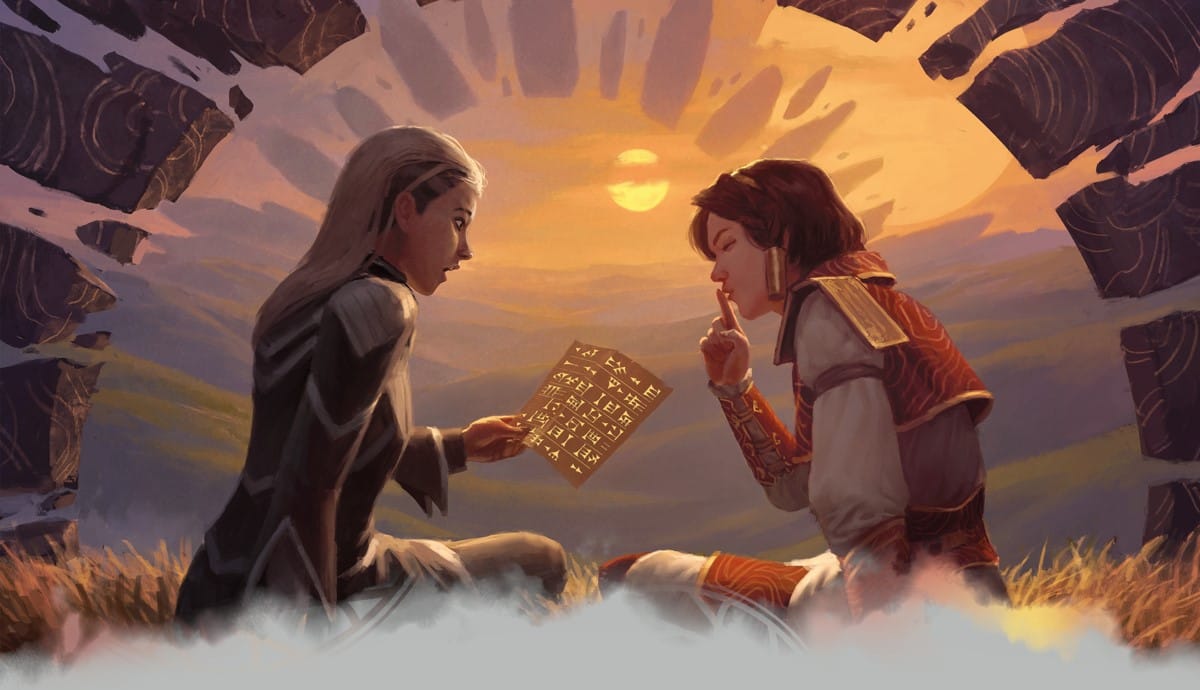
Even the deliberate word choice of Beloved and how it is implemented must be recognized. While it is fair that college is meant to be a place of figuring out who you are and learning to experiment with new life experiences, a lot of RPGs and systems can, unintentionally or otherwise, pressure players into getting bogged down in complex romantic or intimate situations for drama. But in this book, Wizards of the Coast makes a concerted effort to diffuse this sort of trite exaggeration. When an NPC is considered Beloved, it can mean either the character has become a close friend, similar to a close sibling, or a romantic partner. This deliberate word choice manages to be inclusive and open to more life experiences without cheapening a more conventional use of romantic tropes for your group.
The only hitch in this interpretation is that once you have a Beloved, you get a Beloved Inspiration, which can be used once per long rest. Furthermore, you can have a number of Beloved Inspirations equal to your proficiency bonus. If you're looking at this roleplay-centric system strictly in terms of optimal play, it can be argued that Strixhaven is directly encouraging multiple romantic partners or bonds all in the service of additional rolls with advantage. Considering the diverse alignments and tastes of the NPCs in the book, and how much the book encourages your characters to nurture these bonds through long-term roleplay, that kind of min/maxing misses the entire point of the system. Also, while not explicitly stated in the book, plenty of consequences and drama can come from trying to work around these dynamics if you want players to earn and maintain those additional Beloved Inspirations. After all, you can't make everyone like you, and if you try you're just going to make more enemies.
On the topic, it must be said that a lot of focus has gone into making Strixhaven: A Curriculum of Chaos a highly inclusive Dungeons and Dragons supplement. In addition to the more deliberate wording and implementation of a relationship system, there is a concerted effort of natural diversity peppered throughout the supporting cast. In addition to new owlin NPCs and humans from very different walks of life, there are accessibility tools peppered throughout the university. People who can't walk or climb up stairs can use conveniently placed teleportation circles. There are powerful magical items to allow more handicapable students to get around. As a personal example, I had a classic illiterate human Barbarian show up as a student at the school, and he was able to hold his own on tests and exams since there were tools on hand to read text for him and transcribe his answers.
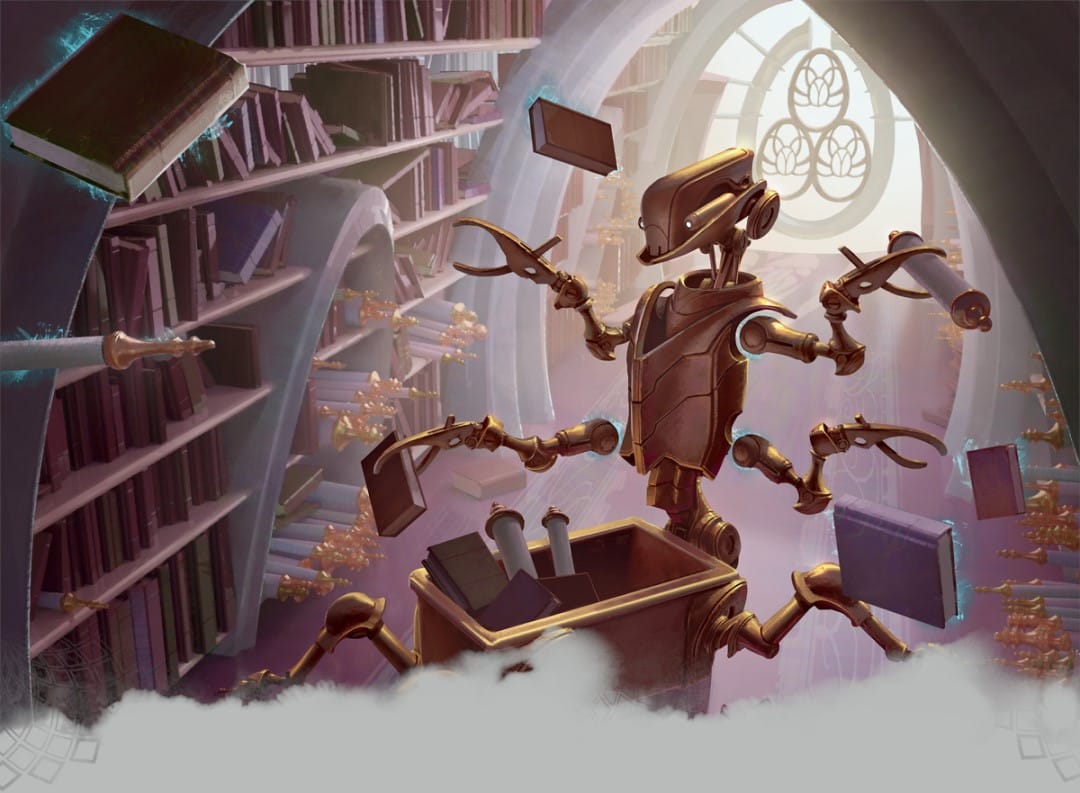
Strixhaven: A Curriculum of Chaos – The Adventures and Roll20
If there is a weak spot in Strixhaven: A Curriculum of Chaos, it would have to be their prewritten adventures. There are four prewritten adventures in the book, each one meant to encompass a single year at the magical university. They can be strung together into an overarching campaign starting at level 1 and ending at level 10, taking your characters from first-year orientation all the way to graduation.
The first of these adventures, Campus Kerfuffle, is the weakest. It retains the issues of a Dungeons and Dragons starting adventure. Specifically, it is more an extended tutorial than a coherent story with stakes and player agency. While there are great roleplaying and social events here, even a fun take on a dungeon crawl, the closest thing to an overarching threat are a collection of loosely connected battle set pieces where the characters are just given the solution at the end, resulting in a trite resolution.
This adventure can be more thematic and theatrical in its presentation with a few quick changes. For example, I switched the last two encounters in the adventure, dropped one or two NPCs, left behind a more organic breadcrumb trail for my players, and upped the CR a bit for the final encounter. This led to my party of PCs protecting their fellow students from a magical mishap gone wrong on a large open stage surrounded by students and professors witnessing their heroism as opposed to them going to a swamp and fighting something because a professor told them to do so.
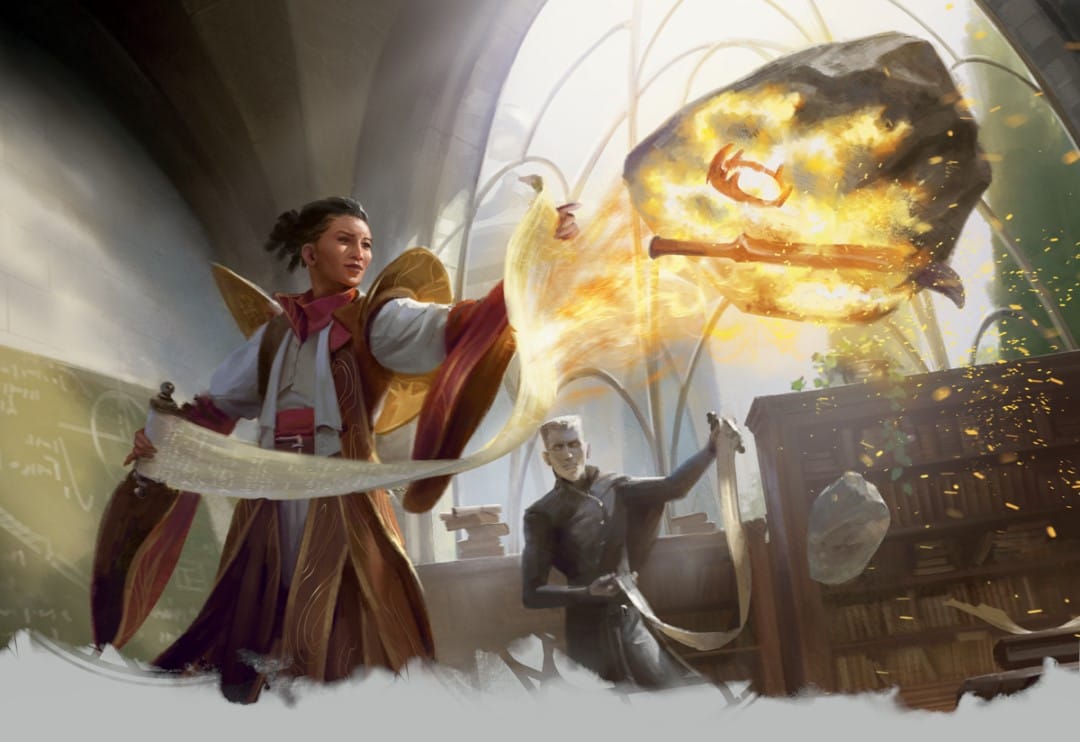
The other two adventures, Hunt for Mage Tower and Magister's Masquerade, make a much better use of the setting. Mixing together social events, exams, and an overarching plot involving dark magic and duplicitous threats are not easy, but these do a much better job making the players feel more involved. The final adventure, A Reckoning in Ruins works as an extended finale and has some great set pieces, but does so at the cost of feeling like a more conventional Dungeons and Dragons adventure.
Finally, it must be noted that all of the notes, maps, and NPCs found in Strixhaven: A Curriculum of Chaos are available as a highly convenient asset pack on Roll20. I've looked over these maps and character handouts myself and can say that they make running a session breezy and effortless. Even if you are more of a theater of the mind DM, the use of shortcuts and cheatsheets make a world of difference. It even includes handouts and quick references to potential status effects and charts you may need to consult from the Player Handbook or Dungeon Master's Guide right there.
There are a few formatting issues I do have, while the new spells in the book are listed, their more pertinent information (what level spell it is, casting time, range, etc.) are not included. In addition, magic item prices are not listed, although a more savvy DM should be able to work around that one. Finally, much like the book itself, there is no dedicated Strixhaven Tracker chart for players, they have to transcribe it for themselves in player notes. These are minor issues that can be fixed. Still, if you have your groups online these days, this is a great alternative.
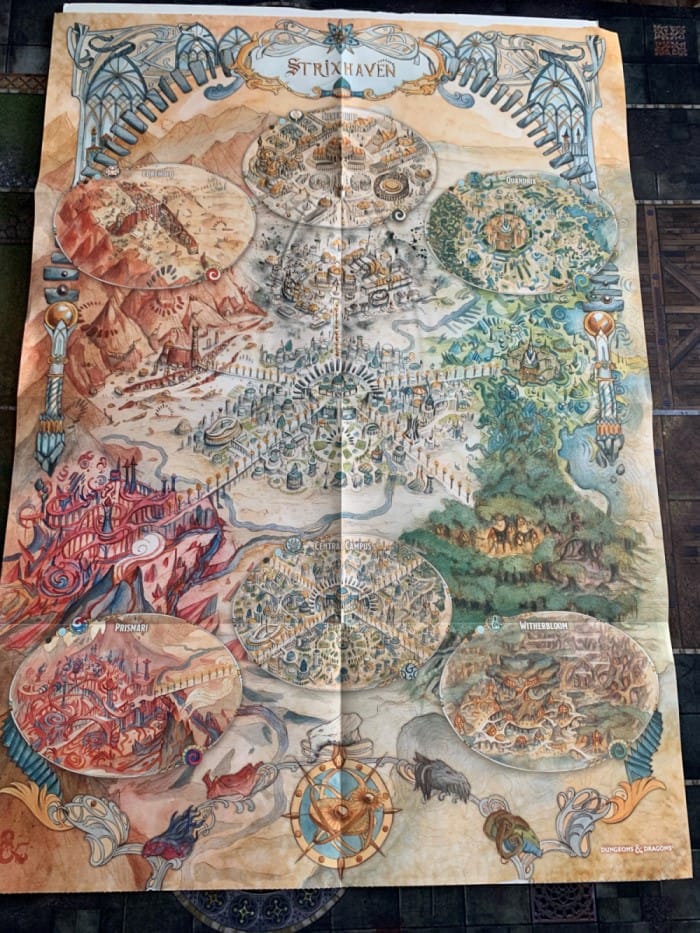
The Bottom Line
If you wanted to take your Dungeons and Dragons group through the trials and tribulations of higher education, than Strixhaven: A Curriculum of Chaos is a must buy. The new exam and relationship systems encourage a lot of interesting social and roleplay encounters. The new spells and feats bring up new possibilities for encounters and puzzles. The world building and monster stat blocks are full of possibilities for grand adventure. Ironically, it feels the most out of step when it feels less like a magic school and more like, well, a Dungeons and Dragons adventure.
Get This Book If...
- You Love Magical School Shenanigans
- You Like Owls
Don't Get This Book If...
- You Want More Combat or Puzzle Encounters
- You Have a Thing Against Inclusiveness (y tho?)
Strixhaven: A Curriculum of Chaos, both physical books and Roll20 assets, were provided by their respective publishers
Review Summary
Have a tip, or want to point out something we missed? Leave a Comment or e-mail us at tips@techraptor.net
